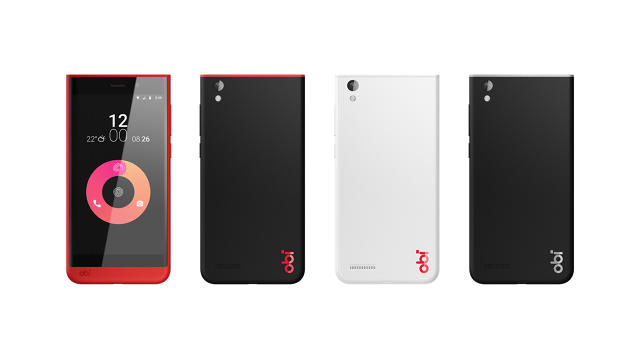Both John Sculley and Ammunition Group's Robert Brunner left Apple before the iPhone era. Sculley, the former CEO of Apple from 1983 to 1993, is perhaps best known as the man who pushed out Steve Jobs; as for Brunner, as the former director of industrial design at Apple, he's the guy who hired Jony Ive.
Now, the former Apple alums are launching their own line of smartphones, called Obi. But although Obi's Android handsets boast a beautiful industrial design worthy of Apple, Obi isn't trying to pick a fight with Cupertino for the high-end of the market. Instead, it's trying to bring Silicon Valley's sleek, agile design philosophies to the fastest growing segment of the international smartphone market: the sub-$200 price point traditionally dominated by OEMs in Asia, Africa, and the Middle East.
Obi's flagship 4G/LTE device is the Worldphone SF1. Its specs are solid: it features a 5-inch display, a 64-bit Qualcomm Snapdragon 615 processor, 2GB of RAM, 16GB of expandable storage, a high-end Sony 13MP processor, Dolby stereo speakers, and support for dual SIMs. The body is made of reinforced fiberglass with metal accents at the top and bottom of the phone; the back has a refined matte finish. On the face of the SF1, the glass screen is elevated, creating a unique, almost dew-drop profile. This also allows the device to slide into sheathe-like protective cases that lie completely flush with the screen. Available in white or black, the SF1 looks and feels luxe, but the price is just $199, unlocked.
Costing just $129, the more affordable Obi Worldphone SJ1.5 is aimed primarily at 3G markets. Like the SF1, it boasts a quad-core processor, this time from Mediatek, as well as a 5-inch display, dual SIM slots, front and rear cameras, and 16GB of expandable internal storage. The design loses the elevated screen of the SF1, taking a more expressive, colorful approach, with unique color and accent options. The design is asymmetrical, with a squared off top and a curved bottom; meanwhile, the curved glass screen cascades off the edges of the device, giving the SJ1.5 a seamless feel in the hand.

Regardless of which Obi phone you get, you still get a device that runs a custom-skinned version of Android Lollipop, and looks, feels, performs, and is packaged like a device that should cost twice as much. They both also feature some extremely clever touches that any luxury phone could proudly sport. According to Sculley, it's all part of a concerted plan to "shift the design center" of the international smartphone market from revolving around $600+ high-end, to a sub-$200 price point that represents the fastest growing segment of the market.
That said, the Obi line of smartphones isn't aimed at an American audience. Rather, it's squarely aimed at high-growth markets with rapidly growing youth populations, many of whom have literally never owned a smartphone, PC, or tablet before. It will go on sale in October in countries like Vietnam, Indonesia, Thailand, the UAE, Saudi Arabia, Kenya, Nigeria, Tanzania, South Africa, Pakistan, Turkey and India. These are countries where smartphones are sold in local shops, where you can't try out the device before hand. That's why both Obi Worldphones feature a beautiful, transparent retail box, designed by Ammunition to look premium and enticing, even behind the counter.

"Here's an industry where many international brands are just hemorrhaging losses," says Sculley. "HTC has gone from over 10% of the market in 2011 to just 2% this year, and the value of the company is just about the value on the balance sheet. Microsoft, meanwhile, has already written off the whole Nokia acquisition. The problem is that everyone keeps focusing on the premium end of the market: they think that's where the money is."
The thesis behind Obi is that a combination of Silicon Valley start-up gumption, the nimbleness that comes from being a relatively small company, and deep integration of design with every aspect of the business could "change the entire cost model" of being successful in the international smartphone market. It's an approach that is already being successfully taken by Chinese companies like Xiaomi and OnePlus, both of whom have leveraged supply chain contacts to deliver extremely well-designed, high-performance smartphones at a fraction of the price of an iPhone. But even their handsets cost more than Obi's.
"There's this common misconception that high quality, high level design is expensive," says Brunner. That's a result of what happens when design is just an "event" that happens in the process of making a product, as opposed to an integral part of every decision, from concept to manufacturing. "From our perspective, we wanted to blow apart this idea that beautiful, high-quality design comes at a high cost. I don't think that's true. If design drives a product from the beginning, you can make a no compromise device."